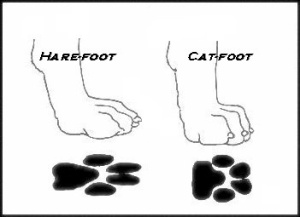“It has been said, “Most of the footprints in the sands of time were made by working shoes.” By the side of those footprints are paw prints.” – Stockdog Savvy
You often hear about reach and drive, but what about feet? Feet support the entire body weight of a dog. The front feet support 60% to 75% of the dog’s weight. As a result, the front feet are slightly larger (broader) than the hind feet. Therefore, correct, sound feet are essential since poor feet can limit athletic ability and lead to impaired performance. Weak feet (splayed, flat, and broken down) are more easily affected by rough terrain and are vulnerable to both wear and injury.
Splayed and flat feet are serious faults because they lead to early breakdown and lameness. Splayed feet expose the webbing to injury. What causes feet to splay? The tendons and ligaments that hold the digits together are lax so the toes spread apart. It’s generally an inherited defect, but can be caused by an injury. When that happens, it will appear in the injured foot only, not in any of the other feet. Long toenails can increase force placed on the digits (toes) and predispose them to fractures and other injuries.
The breed standard states “Feet are oval shaped.” The oval shaped foot described in the breed standard is a semi-hare also known as a modified hare-foot. The modified hare-foot is the most functional type of foot for the Australian Shepherd, a breed that needs to be able to trot for certain distances, change directions, or alter gait instantly in rugged terrain. The longer third digital bones are also helpful for the type of quick initial speed needed for outrunning errant livestock.
Why do judges place Australian Shepherd with cat feet? The shorter third digital bones resulting in the “cat” foot (a deep, round foot with toes nearer the base of the heel of the foot) may be beneficial for sustained, long-distance trotting. However, even though it requires less energy to operate (less power to lift), it also lacks adequate leverage necessary for unusual agility (ability to change direction or alter gait instantly) which is a hallmark for our breed. The modified hare-foot appears to be somewhat flatter than the compact, highly arched, cat foot; however too often judges confuse the slightly flatter toes of the elongated hare foot with flat, and broken down feet.*
The breed standard also states the foot pads should be thick and resilient. Why? The foot pad is where the “rubber meets the road.” This padding is important for traction, shock absorption, and protection from rocky surfaces, briars, thorns, ice granules etc. Thin pads should be faulted. When the heel pad – the central heart-shaped pad – of the foot is thin and poorly developed it causes a dog to stand on the back part of their foot. The third digital bone isn’t adequately supported and the dog’s weight isn’t uniformly dispersed which is evident when the four smaller digital pads tip upwards. This type of foot exposes the feet and webbing to injury and causes the foot to break down.
“Pasterns are short, thick, and strong but still flexible, showing a slight angle when viewed from the side.” Why? The pasterns (metacarpus) work in conjunction with the foot. The pastern expands which helps absorb external forces which in turn minimizes the stress on the bones that form the toes.
*Don’t mistake broken-down cat-feet for the hare-foot which appears somewhat flat. Flat, broken-down feet, those lacking sufficient padding, and splayed feet should be penalized harshly.
For more information about judging, please see my book, All About Aussies:The Australian Shepherd from A to Z (Alpine Publications, Inc.) and The Total Australian Shepherd: Beyond the Beginning by Carol Ann Hartnagle and Ernie Hartnagle: http://lasrocosa.com/education.html
